Bch 3025 exam 1 - Study guides, Class notes & Summaries
Looking for the best study guides, study notes and summaries about Bch 3025 exam 1? On this page you'll find 19 study documents about Bch 3025 exam 1.
All 19 results
Sort by
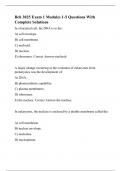
-
Bch 3025 Exam 1 Modules 1-5 Questions With Complete Solutions
- Exam (elaborations) • 58 pages • 2024
-
- $13.99
- + learn more
In a bacterial cell, the DNA is in the: A) cell envelope. B) cell membrane. C) nucleoid. D) nucleus. E) ribosomes. Correct Answer-nucleoid A major change occurring in the evolution of eukaryotes from prokaryotes was the development of: A) DNA. B) photosynthetic capability. C) plasma membranes. D) ribosomes. E) the nucleus. Correct Answer-the nucleus. In eukaryotes, the nucleus is enclosed by a double membrane called the: A) cell membrane. B) nuclear envelope. C) nu...
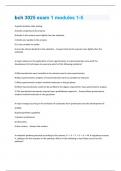
-
bch 3025 exam 1 modules 1-5 Questions And Answers Graded A+
- Exam (elaborations) • 42 pages • 2024
- Available in package deal
-
- $7.99
- + learn more
A good transition-state analog: A) binds covalently to the enzyme. B) binds to the enzyme more tightly than the substrate. C) binds very weakly to the enzyme. D) is too unstable to isolate. E) must be almost identical to the substrate. - Answer-binds to the enzyme more tightly than the substrate. A major advance in the application of mass spectrometry to macromolecules came with the development of techniques to overcome which of the following problems? A) Macromolecules were insoluble i...
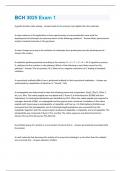
-
BCH 3025 Exam 1 Questions With Correct Answers!!
- Exam (elaborations) • 14 pages • 2024
- Available in package deal
-
- $7.99
- + learn more
A good transition-state analog: - Answer-binds to the enzyme more tightly than the substrate A major advance in the application of mass spectrometry to macromolecules came with the development of techniques to overcome which of the following problems? - Answer-Mass spectrometric analysis involved molecules in the gas phase A major change occurring in the evolution of eukaryotes from prokaryotes was the development of: - Answer-the nucleus A metabolic pathway proceeds according to the schem...

-
bch 3025 exam 1 modules 1-5 Questibch 3025 exam 1 modules 1-5 Questions with Complete Correct Answers | Grade A+ons with Complete Correct Answers | Grade A+
- Exam (elaborations) • 69 pages • 2024
-
- $16.99
- + learn more
In a bacterial cell, the DNA is in the: A) cell envelope. B) cell membrane. C) nucleoid. D) nucleus. E) ribosomes. Ans: nucleoid A major change occurring in the evolution of eukaryotes from prokaryotes was the development of: A) DNA. B) photosynthetic capability. C) plasma membranes. D) ribosomes. E) the nucleus. Ans: the nucleus. In eukaryotes, the nucleus is enclosed by a double membrane called the: A) cell membrane. B) nuclear envelope. C) nucleolus. D) nucleopl...

-
BCH 3025 Exam 1 Modules 1-5 Questions and Answers | Latest Version | 2024/2025 | Already Passed
- Exam (elaborations) • 67 pages • 2024
-
- $11.93
- + learn more
BCH 3025 Exam 1 Modules 1-5 Questions and Answers | Latest Version | 2024/2025 | Already Passed **Where is the DNA located in a bacterial cell?** - A) cell envelope. - B) cell membrane. - C) nucleoid. - D) nucleus. - E) ribosomes. **What was a major evolutionary development in eukaryotes compared to prokaryotes?** - A) DNA. - B) photosynthetic capability. - C) plasma membranes. - D) ribosomes. - E) the nucleus. **In eukaryotic cells, what structure encloses the nucleus...
BCH 3025 Exam 1 Extra with questions and answers (download to pass).
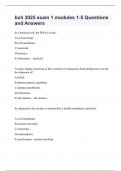
-
bch 3025 exam 1 modules 1-5 Questions and Answers
- Exam (elaborations) • 50 pages • 2024
-
Available in package deal
-
- $12.99
- + learn more
In a bacterial cell, the DNA is in the: A) cell envelope. B) cell membrane. C) nucleoid. D) nucleus. E) ribosomes. - nucleoid A major change occurring in the evolution of eukaryotes from prokaryotes was the development of: A) DNA. B) photosynthetic capability. C) plasma membranes. D) ribosomes. E) the nucleus. - the nucleus. In eukaryotes, the nucleus is enclosed by a double membrane called the: A) cell membrane. B) nuclear envelope. C) nucleolus. D) nucleoplasm....

-
BCH 3025 Exam 1 Questions and Correct Answers
- Exam (elaborations) • 34 pages • 2024
- Available in package deal
-
- $11.49
- + learn more
In a bacterial cell, the DNA is in the: Answer- nucleoid A major change occurring in the evolution of eukaryotes from prokaryotes was the development of: Answer- the nucleus In eukaryotes, the nucleus is enclosed by a double membrane called the: Answer- nuclear envelope The dimensions of living cells are limited, on the lower end by the minimum number of biomolecules necessary for function, and on the upper end by the rate of diffusion of solutes such as oxygen. Except for highly elo...
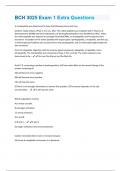
-
BCH 3025 Exam 1 Extra Questions And Answers Graded A+
- Exam (elaborations) • 7 pages • 2024
- Available in package deal
-
- $7.99
- + learn more
A nonapeptide was determined to have the following amino acid com position: (Lys)2, (Gly) 2, (Phe) 2, His, Leu, Met. The native peptide was incubated with 1-fluoro-2,4- dinitrobenzene (FDNB) and then hydrolyzed; 2,4-dinitrophenylhistidine was identified by HPLC. When the native peptide was exposed to cyanogen bromide(CNBr), an octapeptide and free glycine were recovered. Incubation of the native peptide with trypsin gave a pentapeptide, a tripeptide, and free Lys. 2,4-Dinitrophenyl-histidin...
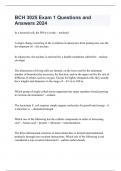
-
BCH 3025 Exam 1 Questions and Answers 2024
- Exam (elaborations) • 17 pages • 2024
-
Available in package deal
-
- $13.99
- + learn more
In a bacterial cell, the DNA is in the: - nucleoid A major change occurring in the evolution of eukaryotes from prokaryotes was the development of: - the nucleus In eukaryotes, the nucleus is enclosed by a double membrane called the: - nuclear envelope The dimensions of living cells are limited, on the lower end by the minimum number of biomolecules necessary for function, and on the upper end by the rate of diffusion of solutes such as oxygen. Except for highly elongated cells, they us...

Study stress? For sellers on Stuvia, these are actually golden times. KA-CHING! Earn from your study resources too and start uploading now. Discover all about earning on Stuvia



